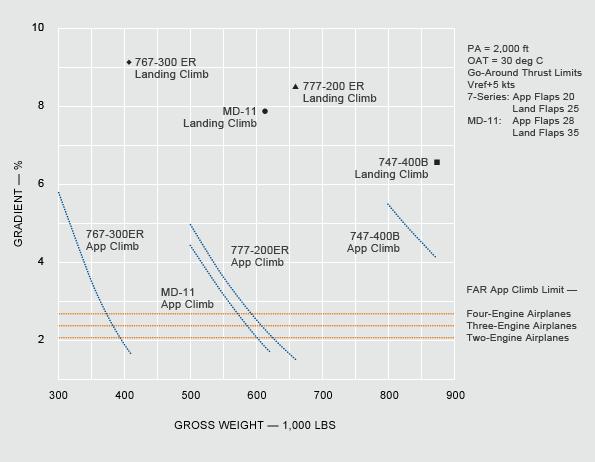
Climb performance exceeds the FAA landing climb gradient requirements (3.2 percent gradient with all engines operating, landing flaps and gear down), even at the maximum design takeoff weight as shown by the Landing Climb symbols in figure 3. Climb performance generally meets the FAA approach gradient requirements (one engine inoperative with approach flaps and gear up) at weights well above maximum design landing weight as shown by the App Climb curves in figure 3, and a positive approach climb gradient is available with one engine inoperative even at the maximum design takeoff weight.
UP TO MAXIMUM TAKEOFF WEIGHT
Figure 3

Normally, landing brake energy is not a problem for an overweight landing because the brakes are sized to handle a rejected takeoff at maximum takeoff weight. When using normal landing flaps, brake energy limits will not be exceeded at all gross weights. When landing at speeds associated with non-normal procedures with nonstandard flap settings, maximum effort stops may exceed the brake energy limits. In these cases, Boeing recommends maximizing use of the available runway for stopping. For Boeing 7-series models other than the 717, techniques for accomplishing this are provided in the overweight landing discussion in the "Landing" chapter of the Boeing flight crew training manuals (FCTM).
The stability and control aspects of overweight landings have been reviewed and found to be satisfactory. Stabilizer trim requirements during approach are unchanged provided normal Vref speeds are flown. Speed stability, the control column force required to vary airspeed from the trimmed airspeed, is slightly improved. Pitch and roll response are unchanged or slightly improved as the increased airspeed more than compensates for increased mass and inertia effects.
Additional information on overweight landing techniques for Boeing 7-series models other than the 717 can be found in the “Landing” chapter of the FCTM.
AUTOMATIC LANDINGS
Overweight automatic landings are not recommended. Autopilots on Boeing airplanes are not certified for automatic landing above the maximum design landing weight. At higher-than-normal speeds and weights, the performance of these systems may not be satisfactory and has not been thoroughly tested. An automatic approach may be attempted; however, the pilot should disengage the autopilot prior to flare height and accomplish a manual landing.
In an emergency, should the pilot determine that an overweight autoland is the safest course of action, the approach and landing should be closely monitored by the pilot and the following factors considered:
- Touchdown may be beyond the normal touchdown zone; allow for additional landing distance.
- Touchdown at higher-than-normal sink rates may result in exceeding structural limits.
- Plan for a go-around or manual landing if autoland performance is unsatisfactory; automatic go-around can be initiated until just prior to touchdown and can be continued even if the airplane touches down after initiation of the go-around.
OVERWEIGHT LANDING INSPECTION REQUIREMENTS
The Boeing airplane maintenance manual (AMM) provides a special inspection that is required any time an overweight landing occurs, regardless of how smooth the landing. The AMM inspection is provided in two parts. The Phase I (or A-check) conditional inspection looks for obvious signs of structural distress, such as wrinkled skin, popped fasteners, or bent components in areas which are readily accessible. If definite signs of overstressing are found, the Phase II (or B-check) inspection must be performed. This is a much more detailed inspection and requires opening access panels to examine critical structural components. The Phase I or A-check conditional inspection can typically be accomplished in two to four labor hours. This kind of inspection is generally not a problem because an airplane that has returned or diverted typically has a problem that takes longer to clear than the inspection itself.

